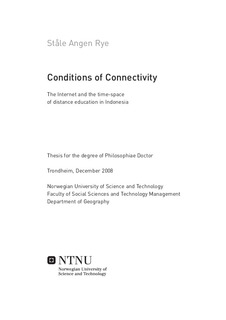| dc.contributor.author | Rye, Ståle Angen | nb_NO |
| dc.date.accessioned | 2014-12-19T14:25:45Z | |
| dc.date.available | 2014-12-19T14:25:45Z | |
| dc.date.created | 2009-02-17 | nb_NO |
| dc.date.issued | 2008 | nb_NO |
| dc.identifier | 174183 | nb_NO |
| dc.identifier.isbn | 978-82-471-1336-3 (Electronic ver.) | nb_NO |
| dc.identifier.isbn | 978-82-471-1334-9 (printed) | nb_NO |
| dc.identifier.uri | http://hdl.handle.net/11250/265292 | |
| dc.description.abstract | This thesis is about how the use of the Internet in distance education has both intended and unintended consequences for people and places in a developing country. The main perspective is the relation between students, educators and the Internet, and how these relations are embedded in the material and social features of the place where the technology is used. Empirically, the research builds on a qualitative case study of distance education in Indonesia and focuses on Universitas Terbuka, one of the world’s largest educational institutions, and students participating in three different Internet supported distance master’s programmes offered by this university.
Together with an introduction (Part 1), the thesis consists of four papers (Part 2). The first paper discusses the importance of the symbolic and political powers of new technology when distance education is developed and spread. The main conclusion is that the symbolic dimension is important in order to realise such projects in the first place, and that concrete results are expected to become more evident in the long run. The second paper discusses how the Internet influences the flexibility of students living in remote areas. It is concluded that the Internet may reduce rather than enhance students’ flexibility in technologically less-advanced places. The third paper reveals how students in a mega-city opt for Internet-supported distance education due to short comings in conventional transportation systems, and how such education influences the social segregation of the city. The fourth and last paper compares the situation for urban students with those living in more remote areas from the perspective of the digital divide. The conclusion is reached that the Internet may be useful for remote areas despite the fact that positive results for students are limited.
A main contribution of this thesis’ research on the Internet and distance education is that it demonstrates how access and the use of Internet for communication are deeply rooted in local practices. It is evident from this thesis that Internet communication in distance education is not merely something happening online between teachers and students, but is inherently related to social, political and material surroundings. What can be learned is that the Internet may help to overcome friction created by space.
Nevertheless, people using the technology are always located in some place, and this place matters for the results from Internet-supported distance education. This thesis therefore suggests that development of Internet-supported distance education should show great awareness of local conditions at the places were such programmes are located. | nb_NO |
| dc.language | eng | nb_NO |
| dc.publisher | Norges teknisk-naturvitenskapelige universitet, Fakultet for samfunnsvitenskap og teknologiledelse, Geografisk institutt | nb_NO |
| dc.relation.ispartofseries | Doktoravhandlinger ved NTNU, 1503-8181; 2008:314 | nb_NO |
| dc.title | Conditions of Connectivity: The Internet and the time-space of distance education in Indonesia | nb_NO |
| dc.type | Doctoral thesis | nb_NO |
| dc.contributor.department | Norges teknisk-naturvitenskapelige universitet, Fakultet for samfunnsvitenskap og teknologiledelse, Geografisk institutt | nb_NO |
| dc.description.degree | PhD i geografi | nb_NO |
| dc.description.degree | PhD in Geography | en_GB |

